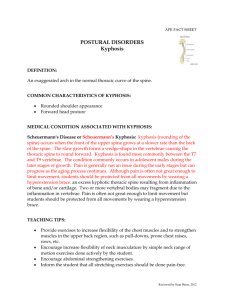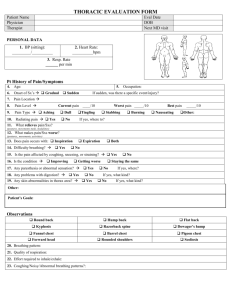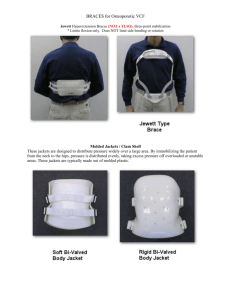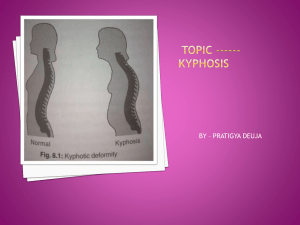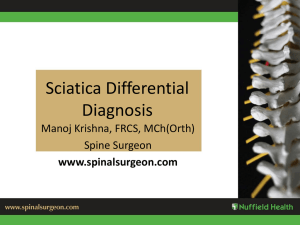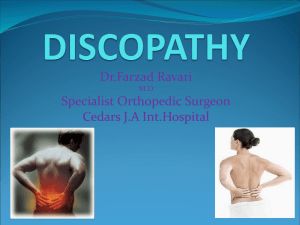12. Thoracic disc disease and Scheuermanns
advertisement
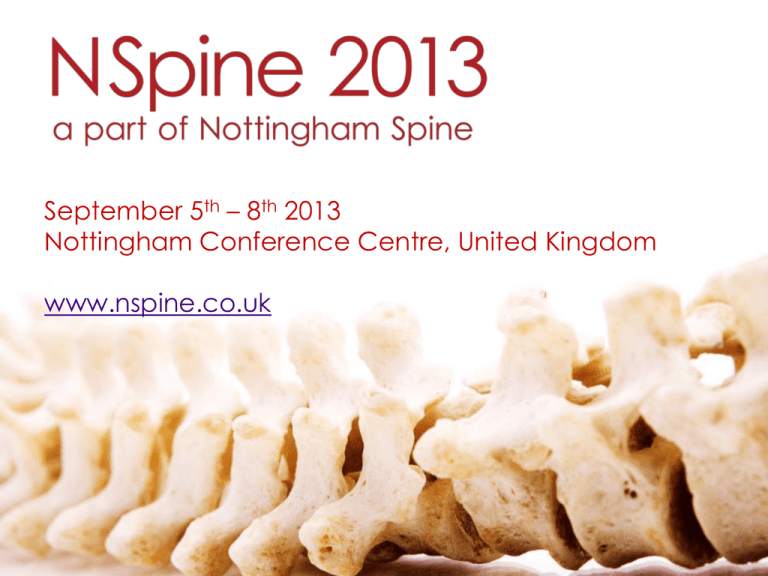
September 5th – 8th 2013 Nottingham Conference Centre, United Kingdom www.nspine.co.uk Thoracic Disc Disease Most common location is at T/L junction & T8-12. Herniated disc Upper back pain, radiating pain & numbness. Degenerative disc disease Conceptually similar to lumbar and cervical disc disorders, but symptomatic lesions are far less common. Disc pathology presentation Often no symptoms! Isolated upper back pain which may radiate in a dermatomal pattern. Muscle spasm & change in posture in thoracic area. Pain exacerbated by coughing, sneezing or twisting. May present with myelopathy sensory disturbances e.g. numbness, below level of compression, difficulty with balance & walking, lower extremity weakness, or bowel or bladder dysfunction. Differential Diagnosis Radiating pain may be perceived to be in chest or abdomen. Therefore need to assess heart, lungs, kidney & GI disorders to exclude non-musculoskeletal causes. DD: Spine fracture (e.g. osteoporotic), infection, tumour & certain metabolic disorders. Thoracic Disc Disease In a study by Wood et al (1995)* 90 asymptomatic patients were scanned with MRI, which revealed 73% had disc abnormalities in the thoracic spine – 37% specifically had a thoracic herniated disc & 29% had spinal cord impingement. On follow up 26 months later none had developed thoracic back pain from their thoracic disc disorders. Study shows that people may have upper back pain & a thoracic herniated disc, but the disc disorder may not be the cause of the thoracic back pain – it may be an incidental finding. *Wood KB, Garvey TA, Gundry C, Heithoff KB. Magnetic resonance imaging of the thoracic spine. J Bone Joint Surgical Am. 77 : 1631-1638, 1995. Scheuermanns Kyphosis A form of juvenile osteochondrosis most commonly affecting the thoracic spine. Higher incidence in males, & appears in adolescents, usually towards the end of their growth spurt. Growth abnormality of vertebral body causes the anterior endplate to grow slower than posteriorly wedge shaped vertebra kyphosis. Kyphosis is rigid & apex is usually T7-9. Normal curvature of Tsp is 20-50. A curvature of >50 where spine has 3 contiguous vertebral bodies that have wedging of 5 or more = Scheuermanns. Scheuermanns Kyphosis Presentation Increased A/P curves - Tsp kyphosis & compensatory Lsp lordosis. Often no pain from Scheuermanns, but more likely to have discomfort or pain with deformity as they age. Notorious for causing Lsp & Csp pain, & pain at apex of kyphosis if severe. Males often have broad, barrel chests. It has been reported that curves in the lower thoracic region cause more pain, whereas curves in the upper region present a more visual deformity. Examination Examine the individual not the diagnosed condition! Postural roundback can be distinguished from Scheuermanns kyphosis by the fact the deformity disappears when the patient lies down. Often tight hamstrings due to increased lordosis in Lsp. Stand against a wall to examine anterior rib mobility so patient can’t employ the Lsp to assist. Is it the thoracic pathology causing the pain or is it a simple mechanical problem? Is their ‘label’ justified as a cause of their pain? Treatment Strategy Work within the limits/parameters of the disorder, with patient cooperation. Treat mechanical issues as individually presented. Key areas to treat: Csp & T/L junction [often find new junctional areas – often at T6/7]. Dependant on how heavily kyphosed & tailored according to maintaining factors – occupation, etc. If the patient is heavily loaded anteriorly, try to balance in supine position with pillow under Tsp. Treatment Considerations With Scheuermanns, need to use long levers. Address segmental restrictions & local muscles as well as the large muscles spanning the spine. Stretch anteriorly. Work with ribs anteriorly & posteriorly, as well as working with key muscles iliocostalis & QL. Articulate & mobilise scapulo-thoracic joints. Often get a pseudo-SIJ problem – don’t symptom chase. Case Presentation Pt: F, 63yrs Presentation: Painful Tsp & Csp with retracted and painful trapezius muscle post 2nd surgery. Left with exposed spinous processes over upper Tsp . PMH: 5yrs previously - T5 discectomy for disc protrusion with cord compression. 1yr previously - T4-6 posterior fusion with ligation of T4 nerve root. Osteopathic Evaluation: Restricted flexion and extension C2 – T1. Hypertonic trapezius, levator scapulae, scalenes and SCM bilaterally. TTT given: Mobilise Csp & Tsp and address soft tissue component. Pre TTT NDI: 58% Post TTT NDI: 32% Significant reduction in disability, reduction of medication and increase in daily activity.
